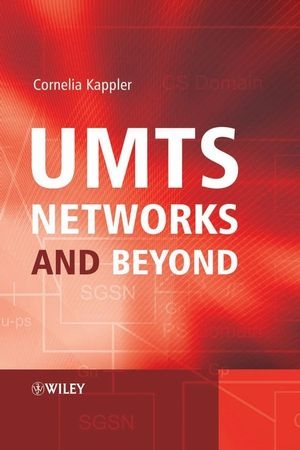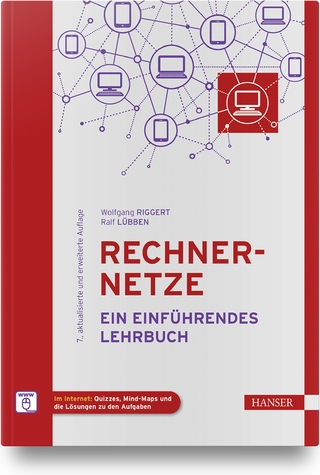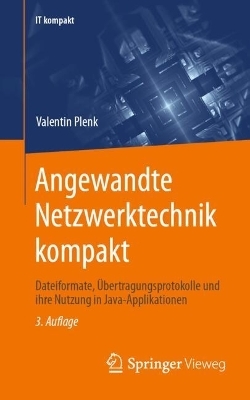
UMTS Networks and Beyond
John Wiley & Sons Inc (Verlag)
978-0-470-03190-2 (ISBN)
An all-encompassing coverage on UMTS Networks including an in-depth discussion of current work on UMTS evolution and 4G . UMTS Networks and Beyond offers a comprehensive introduction to the networking aspects of UMTS and the networks coming after UMTS. The book is unique in that it systematically compares how a particular problem, e.g. obtaining connectivity, is solved in UMTS and how the same problem is solved in a Computer Network such as the Internet. It also highlights why the respective solutions are so different.
The first part of the book provides a detailed technical discussion of UMTS, including original vision, architecture, protocol stacks and overall functionality. It places UMTS in the context of its evolution of from GSM and its convergence with Computer Networks. The second part of the book discusses today’s vision of 4G, and introduces upcoming networking technologies. Emphasis is on LTE / SAE as successor of UMTS; UMB, WiMAX and NGN are also discussed. The book gives an overview of what these technologies are likely to offer, of their architectures, protocols and functionality. It also discusses their differences and similarities, and whether they will qualify as 4G.
Key Features:
Provides readers, particularly those with a background in IP-based networks, with a technical understanding of what UMTS does, how it works and how it is likely to evolve
Explains the differences in design between UMTS Networks and Computer Networks and discusses how these design divergences can be reconciled in the future
Shows how economic considerations shape the design of UMTS
Motivates why particular design choices are made in UMTS
Gives an in-depth introduction to LTE / SAE
Provides a detailed picture of the state of the art in 4G
Illustrates the theory with numerous tables and figures
This comprehensive textbook is essential reading for advanced students and lecturers in communications systems and networking. It is also of interest to engineers and researchers in the field of UMTS and communications systems.
Cornelia Kappler is Senior Researcher and Project Manager for Future Mobile Networks at Siemens Communications, Germany. Cornelia is an expert on UMTS, IP and 4G Networks. She is also Work Packages leader in the Ambient Networks project and an active contributor in the NSIS working group of the IETF. Cornelia has been giving university lectures on UMTS and future mobile systems since 2002, and now teaches courses on UMTS networks at the Technical University of Berlin and at the University of Tübingen, Germany.
Preface xv
Acknowledgement xxi
About the Author xxiii
Acronyms xxv
Part I UMTS Networks
1 Introduction 3
1.1 Mobile Telecommunication Networks and Computer Networks 4
1.2 Network Design Principles and Business Models 5
1.2.1 Business Models 5
1.2.2 The Cathedral and the Bazaar 5
1.2.3 Operator Control and User Control 6
1.2.4 In the Beginning is the Architecture and In the Beginning is the Protocol 7
1.2.5 Convergence 8
1.3 Summary 8
2 UMTS Motivation and Context 11
2.1 The Evolution of the Mobile Telecommunication Market 12
2.1.1 Overall Market Evolution 12
2.1.2 Service Evolution 14
2.2 The Evolution of Mobile Telecommunication Technology 15
2.3 The Genesis of UMTS 17
2.3.1 UMTS Services 18
2.3.2 UMTS Technical Requirements 19
2.4 Comparison of UMTS with Other Mobile Technologies 21
2.4.1 Wlan 21
2.4.2 Other Mobile Technologies 21
2.5 Summary 24
3 Standardization 25
3.1 The Importance of Standardization 26
3.2 Standardization Bodies 27
3.2.1 Itu 27
3.2.2 3gpp 27
3.2.3 3gpp2 29
3.2.4 Ietf 29
3.2.5 Ieee 30
3.3 Summary 31
4 UMTS Architecture and Functionality 33
4.1 Overview of Telecommunication Network Architecture 34
4.1.1 Overview of Mobile Network Functionality 34
4.1.2 User-Plane, Control-Plane and Management Plane 35
4.2 High-Level Architecture of 3G Networks 36
4.3 GSM Architecture 37
4.4 GPRS Architecture 38
4.4.1 PS Domain and CS Domain 39
4.5 UMTS Architecture 39
4.5.1 Ims 40
4.6 3GPP System Architecture 40
4.7 WLAN Architecture 41
4.8 Summary 42
5 UMTS Radio Interface Technology—the Physical Layer 45
5.1 Information Coding 46
5.2 Sharing the Electromagnetic Spectrum 49
5.2.1 Frequency Division 49
5.2.2 Time Division 50
5.2.3 Space Division 50
5.2.4 Code Division 51
5.2.4.1 The Near-Far Effect 52
5.2.4.2 Macrodiversity 53
5.2.4.3 Channelization Code and Scrambling Code 54
5.2.5 Advanced Division Techniques 55
5.2.5.1 Orthogonal Frequency Division Multiple Access 55
5.2.5.2 Single-Carrier Frequency Division Multiplex Access 56
5.3 Summary 57
6 Packet-switched Domain—Architecture and Protocols 59
6.1 Architecture 60
6.1.1 Serving GPRS Support Node (SGSN) 61
6.1.2 Gateway GPRS Support Node (GGSN) 62
6.1.3 Home Location Register (HLR) 62
6.2 Protocols 62
6.2.1 User-Plane 62
6.2.2 Control-Plane 64
6.2.3 Discussion 65
6.3 Summary 66
7 Circuit-switched Domain—Architecture and Protocols 67
7.1 Architecture 68
7.2 Protocols 69
7.2.1 User-Plane 70
7.2.2 Control-Plane 70
7.3 Summary 72
8 UMTS Terrestrial Radio Access Network—Architecture and Protocols 73
8.1 Architecture 73
8.1.1 Node B 75
8.1.2 Rnc 75
8.2 Protocols and Channels 76
8.2.1 User-Plane 77
8.2.2 Control-Plane 77
8.2.3 Lower Layers and Channels 78
8.3 Summary 80
9 User Equipment—Architecture and Protocols 81
9.1 Architecture 81
9.1.1 Te 82
9.1.2 Mt 82
9.1.3 Uicc 83
9.2 Summary 84
10 IP Multimedia Subsystem—Architecture and Protocols 85
10.1 IMS Service Support 86
10.1.1 Basic Service Support 87
10.1.2 Advanced Service Support 87
10.2 Architecture 87
10.2.1 Cscf 89
10.2.2 IP Connectivity Access Network 89
10.3 Protocols 90
10.3.1 User-Plane 90
10.3.2 Control-Plane 90
10.4 Summary 91
10.4.1 Introduction to Chapters 11–17 92
11 Basic UMTS Functionality 93
11.1 Public Land Mobile Network (PLMN) 95
11.2 The Bearer Concept 96
11.3 UE Preparation 96
11.3.1 Searching for a Suitable Cell 97
11.3.2 Searching for a Suitable Network 97
11.4 RRC Connection Set-up Procedure 98
11.4.1 Message Flow for RRC Connection Set-up 98
11.5 GPRS Attach Procedure 99
11.5.1 Mobility Management States 99
11.5.2 Determining the Location of the UE 100
11.5.3 Message Flow for GPRS Attach 101
11.5.4 Combined GPRS/IMSI Attach 102
11.6 PDP Context Establishment Procedure 103
11.6.1 The PDP Context 103
11.6.2 PDP States 104
11.6.3 Message Flow for PDP Context Establishment 104
11.7 Detaching from the Network 105
11.8 Basic UMTS Functionality in Roaming Scenarios 106
11.9 Basic WLAN Functionality 106
11.9.1 Mobile Station Preparation 106
11.9.2 Establishing Radio Connectivity 108
11.9.3 Establishing IP Connectivity 108
11.10 Discussion 108
11.11 Summary 109
12 Mobility 111
12.1 Description of the Problems 112
12.2 Mobility in UMTS 113
12.2.1 Mobility in PMM-IDLE State 114
12.2.1.1 Routing Area Updates 114
12.2.1.2 Paging 116
12.2.2 Mobility in PMM-CONNECTED State 117
12.2.2.1 Handover 117
12.2.2.2 SRNC Relocation 117
12.3 Link-Layer Mobility in a WLAN 118
12.4 Mobility in Computer Networks 119
12.4.1 Basic Mobility Support by the IETF 120
12.4.1.1 Mobile IPv 6 120
12.4.1.2 Mobile IPv 4 121
12.4.2 Advanced Mobility Support by the IETF 122
12.4.2.1 Context Transfer Between Old Access Router and New Access Router 122
12.4.2.2 Seamless Mobility 123
12.4.2.3 Power-Saving Mode and Paging 124
12.5 Discussion 124
12.6 Summary 125
13 Security 127
13.1 Description of the Problems 128
13.1.1 Information Disclosure 129
13.1.2 Information Forgery 129
13.1.3 Theft of Service 130
13.1.4 Denial of Service 131
13.2 General Approach to Solutions 131
13.2.1 Secret Keys 131
13.2.2 Integrity Protection 132
13.2.3 Encryption 133
13.2.4 Authentication 133
13.2.5 Authorization 134
13.2.6 Discussion 134
13.3 Security in UMTS 134
13.3.1 Secret Keys 135
13.3.2 Authentication and Authorization in the PS Domain 135
13.3.3 Authentication and Authorization in the IMS 137
13.3.4 Integrity Protection 137
13.3.4.1 Integrity Protection on the Air Interface 137
13.3.4.2 Integrity Protection in Inter-PLMN Scenarios 138
13.3.5 Encryption 138
13.4 Security in a WLAN 138
13.4.1 Secret Keys 138
13.4.2 Authentication and Authorization 139
13.4.3 Integrity Protection and Encryption 140
13.5 Security Computer Networks 140
13.5.1 Authentication and Authorization 140
13.5.1.1 General Authentication Scenario 140
13.5.1.2 Network Access Authentication Scenario 141
13.5.1.3 Network Access Authentication Scenario with Roaming 141
13.5.1.4 Front end Protocols and back end Protocols 142
13.5.2 Integrity Protection and Encryption 144
13.6 Discussion 144
13.7 Summary 145
14 Quality of Service 147
14.1 Description of the Problems 148
14.1.1 QoS and Scalability 148
14.1.2 QoS Parameterization 149
14.1.3 QoS Signalling and QoS Provisioning 150
14.1.4 QoS and Seamless Mobility 151
14.2 QoS in Computer Networks 151
14.2.1 QoS Provisioning 152
14.2.1.1 Overprovisioning 152
14.2.1.2 Differentiated Services 154
14.2.1.3 Integrated Services 155
14.2.1.4 Mpls 155
14.2.2 QoS Signalling 157
14.2.2.1 Rsvp 157
14.2.2.2 QoS NSLP 160
14.2.2.3 Sip 160
14.2.3 End-to-end QoS Signalling Scenarios 161
14.3 QoS in UMTS 162
14.3.1 UMTS Traffic Classes 162
14.3.2 QoS Signalling for the UMTS Bearer 163
14.3.2.1 UMTS QoS Signalling to the PS Domain 163
14.3.3 UMTS QoS Provisioning 163
14.3.4 QoS of the End-to-End Bearer in UMTS 164
14.3.4.1 Service Level Agreements 164
14.3.4.2 UMTS End-to-end QoS Scenarios 164
14.4 Link-Layer QoS in a WLAN 166
14.5 Discussion 166
14.6 Summary 167
15 Session Control 169
15.1 Description of the Problems 170
15.2 Sip 171
15.2.1 SIP Identifiers 171
15.2.2 SIP Infrastructure 172
15.2.3 SIP Transactions 173
15.2.4 Session Description 174
15.2.5 SIP Example Message Flows 175
15.3 SIP in the IMS 177
15.3.1 SIP Infrastructure in the IMS 178
15.3.1.1 Proxy CSCF 178
15.3.1.2 Serving CSCF 179
15.3.1.3 Interrogating CSCF 179
15.3.1.4 SIP Octagon 179
15.3.2 UE Registration in the IMS 180
15.3.2.1 Message Flow for UE Registration in the IMS 181
15.3.3 Session Creation in the IMS 182
15.3.3.1 Message Flow for Session Creation in the IMS 183
15.3.4 Session Release and UE Deregistration in the IMS 185
15.4 Discussion 186
15.5 Summary 186
16 Charging 189
16.1 Description of the Problems 190
16.2 Charging in Computer Networks and WLAN 192
16.3 Charging in UMTS 192
16.3.1 Offline Charging and Online Charging 193
16.3.2 UMTS Charging Architecture 194
16.3.2.1 Offline Charging Architecture 195
16.3.2.2 Online Charging Architecture 196
16.3.2.3 Flow-based Charging 197
16.3.3 Charging in the PS Domain 200
16.3.3.1 Offline Charging in the PS Domain 201
16.3.3.2 Online Charging in the PS Domain 201
16.3.3.3 Roaming Scenario 202
16.3.4 Charging in the IMS 202
16.3.4.1 Offline Charging in the IMS 202
16.3.4.2 Online Charging in the IMS 204
16.3.4.3 Roaming Scenario 204
16.4 Discussion 204
16.5 Summary 205
17 Policy Control 207
17.1 Description of the Problems 208
17.2 Policy Control in Computer Networks 209
17.2.1 Policy Control in Roaming 209
17.2.2 Policy Control in QoS Authorization 210
17.2.3 The IETF Policy Architecture 210
17.2.4 Policy Push 211
17.3 Policy Control in UMTS 212
17.3.1 Service-based Local Policy 212
17.3.1.1 Message Flow for Service-based Local Policy 213
17.3.2 Policy and Charging Control 215
17.3.2.1 Policy and Charging Control in Roaming Scenarios 217
17.4 Discussion 217
17.5 Summary 219
18 WLAN and Other Alternative Access Methods 221
18.1 Interworking WLAN 222
18.1.1 I-WLAN Scenarios 222
18.1.2 I-WLAN Architecture 223
18.1.2.1 Non-roaming Case 224
18.1.2.2 Roaming Case 226
18.1.3 I-WLAN Basic Functionality 226
18.1.4 I-WLAN Mobility 227
18.1.5 I-WLAN Security 227
18.1.6 I-WLAN QoS 227
18.1.7 I-WLAN Charging 228
18.1.8 I-WLAN Policy Control 228
18.2 Generic Access Network 229
18.2.1 Enhanced GAN 232
18.3 Comparison and Discussion 232
18.4 Femtocells 233
18.5 Summary 234
19 UMTS Releases Summary 235
19.1 Release 99 235
19.2 Release 4 236
19.3 Release 5 236
19.4 Release 6 236
19.5 Release 7 237
19.6 Outlook 239
Part I Epilogue—Convergence 241
Part II Beyond UMTS Networks
20 4G Motivation and Context 245
20.1 Today’s Mobile Telecommunication Networks 246
20.1.1 Today’s Services and Technology Trends 246
20.1.1.1 Regional Differences 248
20.1.1.2 Summary of Today’s Services and Technology Trends 248
20.1.2 Today’s Business Models 248
20.1.2.1 Connectivity Provisioning 249
20.1.2.2 Service Provisioning 250
20.1.2.3 Summary of Today’s Business Models 251
20.2 Short-term Evolution Towards 4G 251
20.2.1 Short-term Service and Technology Trends 251
20.2.1.1 User Services 251
20.2.1.2 Radio Interface and Bandwidth 252
20.2.1.3 Access Network 252
20.2.1.4 Mobile Stations and Networks of Mobile Stations 255
20.2.1.5 Service Creation 260
20.2.1.6 Summary of Short-term Services and Technology Trends 260
20.2.2 Short-term Business Models 260
20.3 IMT-Advanced 262
20.3.1 IMT-Advanced Services and Technologies 262
20.3.1.1 Radio Interface and Bandwidth 262
20.3.1.2 Access Networks 263
20.3.1.3 Mobile Terminals 263
20.3.1.4 Service Creation 264
20.3.1.5 Other Technical Features 265
20.3.1.6 IMT-Advanced Architecture 265
20.3.2 Summary of IMT-Advanced 266
20.4 Discussion 266
20.5 Summary 267
21 Evolution Towards 4G: 3GPP 269
21.1 3GPP Rel-8—Architecture and Protocols 271
21.2 E-utra 271
21.3 EPC—Architecture and Protocols 273
21.3.1 High-level View of the EPC Architecture and Protocols 273
21.3.2 Detailed EPC Architecture and Protocols 274
21.3.2.1 3GPP Access Network Architecture 274
21.3.2.2 3GPP Access Network Protocols 276
21.3.2.3 Untrusted non-3GPP Access Network Architecture 277
21.3.2.4 Untrusted non-3GPP Access Network Protocols 278
21.3.2.5 Trusted non-3GPP Access Network Architecture 278
21.3.2.6 Trusted non-3GPP Access Network protocols 279
21.3.2.7 Pgw 279
21.3.3 E-UTRAN: Architecture and Protocols 280
21.3.3.1 E-UTRAN Architecture 280
21.3.3.2 Protocols and Channels 280
21.4 3GPP Rel-8 Functionality 281
21.4.1 Basic Functionality 281
21.4.1.1 Proxy Mobile IP 282
21.4.1.2 Network Attach 284
21.4.1.3 Dedicated Bearer Establishment 286
21.4.1.4 Detaching 287
21.4.1.5 Roaming 287
21.4.2 Mobility 288
21.4.2.1 Mobility within 3GPP Access Networks 289
21.4.2.2 Mobility Involving non-3GPP Access Networks 290
21.4.3 Security 291
21.4.3.1 Secret Keys 292
21.4.3.2 Authentication and Authorization 292
21.4.3.3 Encryption and Integrity Protection 292
21.4.4 QoS 293
21.4.4.1 QoS Parameterization 293
21.4.4.2 QoS Signalling 293
21.4.5 Charging 294
21.4.6 Policy Control 294
21.5 Discussion 294
21.6 Summary 294
22 Evolution Towards 4G: Non-3GPP Technologies 297
22.1 cdma 2000 298
22.1.1 cdma2000-1xRTT and cdma2000-1xEV-DO 299
22.1.2 Umb 299
22.1.2.1 Radio Interface 299
22.1.2.2 Architecture and Protocols 299
22.1.2.3 Interworking with Other Technologies 301
22.2 Mobile WiMAX 301
22.2.1 Radio Interface 302
22.2.2 Architecture and Protocols 302
22.2.3 Interworking with Other Technologies 304
22.2.4 Mobile WiMAX and IMT-Advanced 304
22.3 Next Generation Networks 304
22.3.1 Etsi Ngn 305
22.3.1.1 Architecture and Protocols 305
22.3.1.2 Interworking with Other Technologies 307
22.3.2 PacketCable 307
22.3.2.1 Architecture and Protocols 308
22.3.2.2 Protocols 309
22.3.2.3 Interworking with Other Technologies 309
22.4 Discussion 310
22.5 Summary 311
23 Beyond 4G? 313
23.1 Self-managing Networks 313
23.1.1 Self-management in a 3GPP System 315
23.1.2 Discussion 316
23.2 Ubiquitous Computing, the Internet of Things and Ambient Intelligence 316
23.3 Clean Slate Approach 318
23.3.1 Discussion 319
23.4 Summary 319
Part II Epilogue—Convergence Revisited 321
Appendix A: Terminology 323
Appendix B: The Systematics of 3GPP Specification Numbering 327
References 331
Index 337
| Erscheint lt. Verlag | 30.3.2009 |
|---|---|
| Verlagsort | New York |
| Sprache | englisch |
| Maße | 178 x 253 mm |
| Gewicht | 822 g |
| Themenwelt | Mathematik / Informatik ► Informatik ► Netzwerke |
| Technik ► Elektrotechnik / Energietechnik | |
| Technik ► Nachrichtentechnik | |
| ISBN-10 | 0-470-03190-5 / 0470031905 |
| ISBN-13 | 978-0-470-03190-2 / 9780470031902 |
| Zustand | Neuware |
| Haben Sie eine Frage zum Produkt? |
aus dem Bereich


